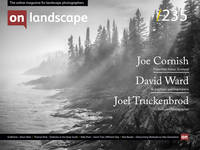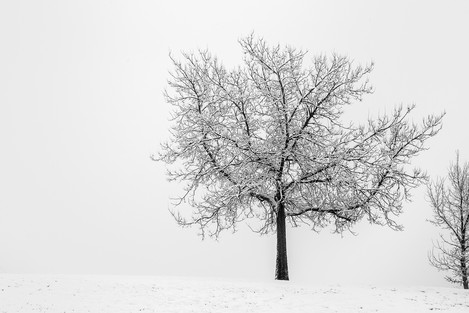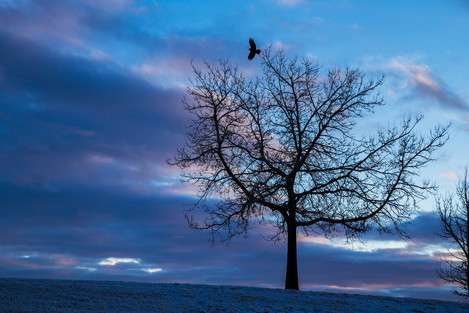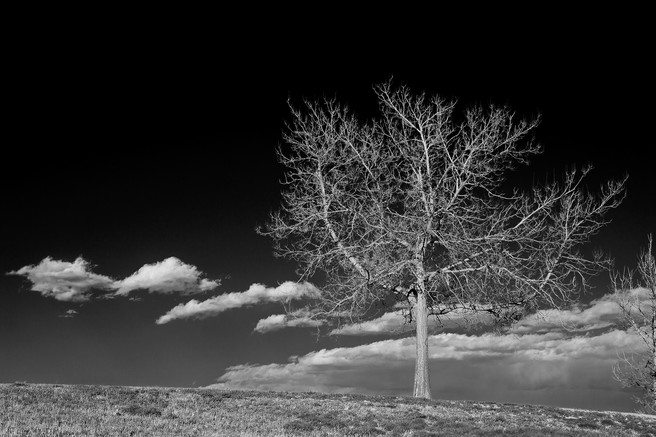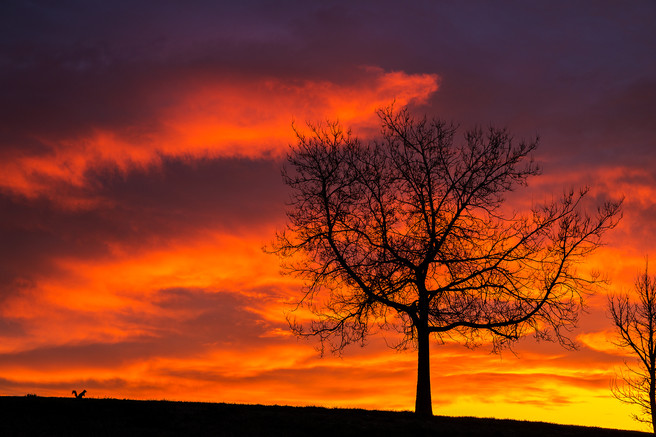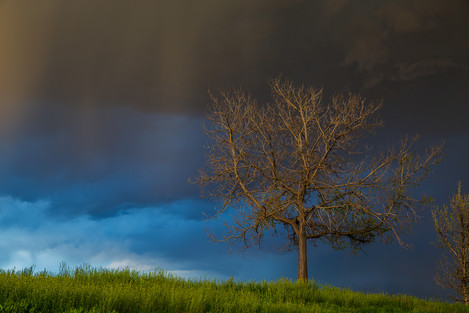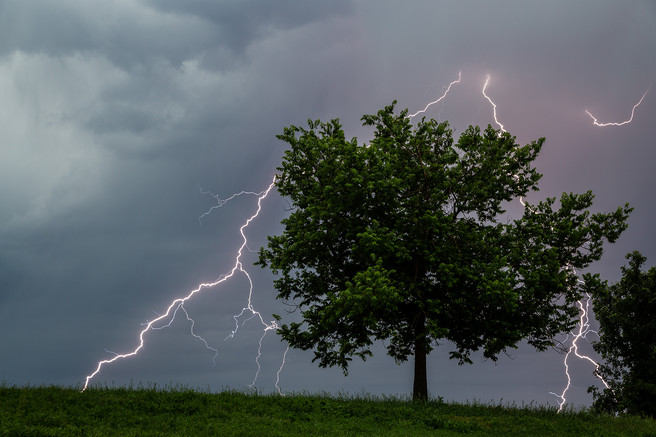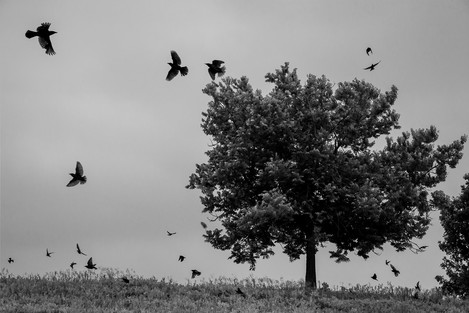Did you ever think that a tree could change your life?

Mike Pach
Mike Pach was born in Chicago in 1967. He moved to St. Louis in 1989 after earning a bachelor’s degree in aerospace engineering from Parks College of St. Louis University. He fell in love with the mountains and photography on his first visit to Colorado in 1984 during a five-day backpacking trip with a borrowed camera. He spent two summers in college working as a backcountry guide for Meet the Wilderness, the same organization that hosted his backpacking trip. . Pach moved to Pueblo in 1996 to fulfil his dream of living in Colorado and then moved to Colorado Springs in 2002. He started his first photography-related business in 2000 after his engineering career ended, and opened 3 Peaks Photography & Design in 2009.
Did you ever think that a tree could change your life? A hackberry tree in a park behind my home in Colorado Springs, Colorado, did just that because I chose to photograph it one winter’s day. And six years later, I’m still inspiring people with the photos and lessons that I learned from a project I call “Same Tree, Different Day.”
One of the things I like most about this project is that it wasn’t planned. The idea came to me on January 12, 2015, the day after a snowstorm. I was working from home, and while on my lunch break, I noticed that the tree looked amazing while covered in snow and ice as I viewed it through my patio door. Captivated by the scene, I set up my camera on my tripod in the backyard and took a picture. Later that afternoon, the thought occurred to me to take a photo of the tree every day for a year just to see what would happen. I decided to follow through on that thought, and I had no clue at the time how this simple idea would end up impacting my life.
I first set out to create a unique image of the same subject every day from the same vantage point. I was diagnosed with fibromyalgia in 2008, and one of my biggest concerns at the time was whether or not I could still be creative if my body would no longer allow me to go on the long hikes in the Colorado Mountains that I enjoyed. I wanted to prove that I could be creative in a confined area. I also wanted to prove that anyone can get amazing photos without travelling hundreds or thousands of miles. Working from home allowed me the opportunity to monitor what was going on outside so I could take advantage of unique situations when they occurred. I also used props and cameo appearances to create my own unique situations to photograph.
Once I got started, I realised that it would be helpful to set some ground rules, guidelines and goals. I knew for a variety of reasons that it would be difficult to have the camera set up in the exact same spot every day, so I devised a method for getting close enough with each shot. I also decided that I would rather have some slight variation in the position of the tree within the frame. I placed two rectangular pavers in my yard for me to stand on. Since I knew where to put my feet, I could then set up my tripod in almost the same place each time I photographed the tree. For each photo, I made sure my camera was level horizontally, and I lined up the right edge of the frame with the trunk of the smaller tree to the right of the main tree. This method provided some consistency while allowing for minor variations.
Another one of my goals was to get up for sunrise every day with the hope of capturing amazing colours in the sky. This was a big challenge because I’m not a morning person. I deal with three medical conditions that are each considered disabilities, and this combination makes it difficult for me to get out of bed on most days. I developed a routine where I would set my alarm for 15-30 minutes prior to sunrise. Upon awakening, I would get up and look out my bedroom window, which faced the tree. If there were clouds in the sky, it meant there was a good chance the sunrise would be colourful. I would then get dressed, set up my camera in the yard and wait for the sun to come up. If there were no clouds in the sky, I would go back to bed and hope for interesting conditions later in the day or for a good sunset.
Staying motivated to capture a photo every day was difficult at first, but I incorporated a method into my routine that utilises a yearly wall calendar to track one’s progress. I placed an X on the calendar each day when I reached my goal of creating an image and posting it to my blog. It’s best to place the calendar in a highly visible location, and for me, that was the wall I faced when working at my computer. Seeing the string of Xs grow gave me a real sense of accomplishment and the motivation I needed to keep going.
I faced another challenge that I never talked about before in public. I am sensitive to chemicals and smells, including cigarette smoke, laundry products and car fumes. Living in a condo complex meant that on many occasions, someone would be running their dryer or smoking outside while I was in my yard. I would have to wear a mask if I wanted to take a picture of the tree while being exposed to bothersome chemicals, or I would have to try to capture a photo at a time when it was safer for me to do so.
I learned many things as a result of working on this project. The most profound thing I learned is that I was provided with everything I needed to make a great photo every day. Basically, all I needed to do was just show up and be patient.
This project changed my perspective on photography. I realised that making a connection with your subject and practising mindfulness results in better photos, and I’ve started teaching this concept to my students. I have many stories that I share of instances where a series of events lead me to believe that I was intentionally placed in a position to get an amazing photograph at exactly the right time. I call these happenings “signs from the Universe.” Each occurrence reinforced the feeling that I was doing something I was meant to do, which gave the project a deeper meaning for me.
I learned that I could reach any goal I set my mind to with the help of the yearly wall calendar. The use of this simple tool is a great source of motivation because you can easily see how much progress you’re making when you’re working on a monumental task. This tracking method illustrates how seemingly impossible things can be accomplished by tackling them one step at a time. I teach people how to use this method to reach their own goals, and I’ve also created my own calendars with photos from this series.
The most important thing that I learned is how having a daily goal is beneficial to managing your mental health. I have lived with depression and anxiety since high school, and there were difficult times during this year-long period when all I could do or all I wanted to do was take my photo of the tree and post it to my blog. I spent the previous year questioning my existence, and this daily routine gave my life purpose and provided a good reason for me to get out of bed every day. This project is an excellent example of what one can do to bring meaning to the instances of isolation and loneliness like those that many people faced during the COVID-19 pandemic. Mental health issues and cases of suicide have increased dramatically in recent months, and I feel that sharing my lived experience can help others who are struggling. I want to share what I’ve learned with as many people as possible because those lessons have the power to save lives.
We all have brilliant ideas for projects. The problem is that most of us never follow through on those ideas, or what I call “brainstorms,” because we think we won’t have the time or end up convincing ourselves that whatever we thought of is not worthwhile. You never know what is going to come out of completing a project and where it will lead you, so my biggest piece of advice is to just do it because getting started is probably the hardest part.
Besides using a calendar to track your progress, it’s helpful to set your goals and expectations for your project early on, but it’s also important to be open to considering other ideas as they come along that may make things more interesting or make your goals easier to achieve. Also, make sure that your goals are attainable. If you tie yourself down with too many restrictions, that will only make a difficult project even more difficult to complete, which could deplete your interest and your motivation.
I’ve now lectured about Same Tree, Different Day, dozens of times and have had this work featured in several publications. My biggest highlight so far has been speaking at the Canadian Mental Health Association Conference in Toronto in September of 2019. While I was there, I was filled with an overwhelming sense of gratitude and experienced many signs from the Universe that I was in the right place. During the entire conference, I repeatedly thought to myself, “Just because you chose to take a photo of the tree one day, you’re now in Toronto talking about this experience!” This project turned into so much more than just a series of photos. I’ve become a mental health advocate, and I hope my talk in Toronto is the first of many presentations at national-level conferences.

